Integrated Affinity Biosensing Platforms on Screen-Printed Electrodes Electrografted with Diazonium Salts
Abstract
:1. Introduction
2. Aryl Diazonium Salt Chemistry in Electrochemical Affinity Biosensing
2.1. Electrochemical Immunosensors Involving Aryl Diazonium Salt Chemistry onto Screen-Printed Electrodes
2.2. Electrochemical Nucleic Acid Biosensors Involving Aryl Diazonium Salt Chemistry onto Screen-Printed Electrodes
2.3. Other Electrochemical Biosensors Involving Aryl Diazonium Salt Chemistry onto Screen-Printed Electrodes
3. General Considerations, Challenges and Prospects
Acknowledgments
Author Contributions
Conflicts of Interest
References
- Kokkinos, C.; Economou, A.; Prodromidis, M.I. Electrochemical immunosensors: Critical survey of different architectures and transduction strategies. Trends Anal. Chem. 2016, 79, 88–105. [Google Scholar] [CrossRef]
- Felix, F.S.; Angnes, L. Electrochemical immunosensors—A powerful tool for analytical applications. Biosens. Bioelectron. 2018, 102, 470–478. [Google Scholar] [CrossRef] [PubMed]
- Du, Y.; Dong, S. Nucleic acid biosensors: Recent advances and perspectives. Anal. Chem. 2017, 89, 189–215. [Google Scholar] [CrossRef] [PubMed]
- Schreiber, A.; Feldbrugge, R.; Key, G.; Glatz, J.F.C.; Spencer, F. An immunosensor based on disposable electrodes for rapid estimation of fatty acid-binding protein, an early marker of myocardial infarction. Biosens. Bioelectron. 1997, 12, 1131–1137. [Google Scholar] [CrossRef]
- Hayat, A.; Barthelmebs, L.; Sassolas, A.; Marty, J.-L. An electrochemical immunosensor based on covalent immobilization of okadaic acid onto screen printed carbon electrode via diazotization-coupling reaction. Talanta 2011, 85, 513–518. [Google Scholar] [CrossRef] [PubMed]
- Cosnier, S. Biomolecule immobilization on electrode surfaces by entrapment or attachment to electrochemically polymerized films: A review. Biosens. Bioelectron. 1999, 14, 443–456. [Google Scholar] [CrossRef]
- Butterfield, D.A.; Colvin, J.; Liu, J.L.; Wang, J.Q.; Bachas, L.; Bhattacharya, D. Electron paramagnetic resonance spin label titration: A novel method to investigate random and site-specific immobilization of enzymes onto polymeric membranes with different properties. Anal. Chim. Acta 2002, 470, 29–36. [Google Scholar] [CrossRef]
- Shen, L.; He, P. An electrochemical immunosensor based on agarose hydrogel films for rapid determination of ractopamine. Electrochem. Commun. 2007, 9, 657–662. [Google Scholar] [CrossRef]
- Cosnier, S. Recent advances in biological sensors based on electrogenerated polymers: A review. Anal. Lett. 2007, 40, 1260–1279. [Google Scholar] [CrossRef]
- Teles, F.R.R.; Fonseca, L.P. Applications of polymers for biomolecule immobilization in electrochemical biosensors. Mater. Sci. Eng. C 2008, 28, 1530–1543. [Google Scholar] [CrossRef]
- Nuzzo, R.G.; Allara, D.L. Adsorption of bifunctional organic disulfides on gold surfaces. J. Am. Chem. Soc. 1983, 105, 4481–4483. [Google Scholar] [CrossRef]
- Wilson, D.L.; Martin, R.; Hong, S.; Cronin-Golomb, M.; Mirkin, C.; Kaplan, D. Surface organization and nanopatterning of collagen by dip-pen nanolithography. Proc. Natl. Acad. Sci. USA 2001, 98, 13660–13664. [Google Scholar] [CrossRef] [PubMed]
- Sassolas, A.; Leca-Bouvier, B.D.; Blum, L.J. DNA biosensors and microarrays. Chem. Rev. 2008, 108, 109–139. [Google Scholar] [CrossRef] [PubMed]
- Demers, L.M.; Ginger, D.S.; Park, S.J.; Li, Z.; Chung, S.W.; Mirkin, C.A. Direct patterning of modified oligonucleotides on metals and insulators by dip-pen nanolithography. Science 2002, 296, 1836–1838. [Google Scholar] [CrossRef] [PubMed]
- MacBeath, G.; Schreiber, S.L. Printing proteins as microarrays for high-throughput function determination. Science 2000, 289, 1760–1763. [Google Scholar] [PubMed]
- Zhu, H.; Bilgin, M.; Bangham, R.; Hall, D.; Casamayor, A.; Bertone, P.; Lan, N.; Jansen, R.; Bidlingmaier, S.; Houfek, T.; et al. Global analysis of protein activities using proteome chips. Science 2001, 293, 2101–2105. [Google Scholar] [CrossRef] [PubMed]
- Cernat, A.; Tertiş, M.; Cristea, C.; Săndulescu, R. Applications of click chemistry in the development of electrochemical sensors. Int. J. Electrochem. Sci. 2015, 10, 6324–6337. [Google Scholar]
- Verma, P.; Maire, P.; Novak, P. Concatenation of electrochemical grafting with chemical or electrochemical modification for preparing electrodes with specific surface functionality. Electrochim. Acta 2011, 56, 3555–3561. [Google Scholar] [CrossRef]
- Moreno-Guzmán, M.; Ojeda, I.; Villalonga, R.; González-Cortés, A.; Yáñez-Sedeño, P.; Pingarrón, J.M. Ultrasensitive detection of adrenocorticotropin hormone (ACTH) using disposable phenylboronic-modified electrochemical immunosensors. Biosens. Bioelectron. 2012, 35, 82–86. [Google Scholar] [CrossRef] [PubMed]
- Eissa, S.; Tlili, C.; L’Hocine, L.; Zourob, M. Electrochemical immunosensor for the milk allergen β-lactoglobulin based on electrografting of organic film on graphene modified screen-printed carbon electrodes. Biosens. Bioelectron. 2012, 38, 308–313. [Google Scholar] [CrossRef] [PubMed]
- Hayat, A.; Sassolas, A.; Marty, J.-L.; Radi, A.-E. Highly sensitive ochratoxin A impedimetric aptasensor based on the immobilization of azido-aptamer onto electrografted binary film via click chemistry. Talanta 2013, 103, 14–19. [Google Scholar] [CrossRef] [PubMed]
- Zhang, Y.; Geng, X.; Ai, J.; Gao, Q.; Qi, H.; Zhang, C. Signal amplification detection of DNA using a sensor fabricated by one-step covalent immobilization of amino-terminated probe DNA onto the polydopamine-modified screen-printed carbon electrode. Sens. Actuators B Chem. 2015, 221, 1535–1541. [Google Scholar] [CrossRef]
- Zheng, W.; van den Hurk, R.; Cao, Y.; Du, R.; Sun, X.; Wang, Y.; McDermott, M.T.; Evoy, S. Aryl diazonium chemistry for the surface functionalization of glassy Biosensors. Biosensors 2016, 6, 8. [Google Scholar] [CrossRef] [PubMed]
- Harper, J.C.; Polsky, R.; Wheeler, D.R.; Dirk, S.M.; Brozik, S.M. Selective immobilization of DNA and antibody probes on electrode arrays: Simultaneous electrochemical detection of DNA and protein on a single platform. Langmuir 2007, 23, 8285–8287. [Google Scholar] [CrossRef] [PubMed]
- Corgier, B.P.; Laurent, A.; Perriat, P.; Blum, L.J.; Marquette, C.A. A versatile method for direct and covalent immobilization of DNA and proteins on biochips. Angew. Chem. Int. Ed. 2007, 46, 4108–4110. [Google Scholar] [CrossRef] [PubMed]
- Polsky, R.; Harper, J.C.; Wheeler, D.R.; Dirk, S.M.; Arango, D.C.; Brozik, S.M. Electrically addressable diazonium-functionalized antibodies for multianalyte electrochemical sensor applications. Biosens. Bioelectron. 2008, 23, 757–764. [Google Scholar] [CrossRef] [PubMed]
- Bélanger, D.; Pinson, J. Electrografting: A powerful method for surface modification. Chem. Soc. Rev. 2011, 40, 3995–4048. [Google Scholar] [CrossRef] [PubMed]
- Randriamahazaka, H.; Ghilane, J. Electrografting and controlled surface functionalization of carbon based surfaces for electroanalysis. Electroanalysis 2016, 2, 13–26. [Google Scholar] [CrossRef]
- Corgier, B.P.; Marquette, C.A.; Blum, L.J. Diazonium-protein adducts for graphite electrode microarrays modification: Direct and addressed electrochemical immobilization. J. Am. Chem. Soc. 2005, 127, 18328–18332. [Google Scholar] [CrossRef] [PubMed]
- Jiang, C.; Silva, S.M.; Fan, S.; Wu, Y.; Alam, M.T.; Liu, G.; Gooding, J.J. Aryldiazonium salt derived mixed organic layers: From surface chemistry to their applications. J. Electroanal. Chem. 2017, 785, 265–278. [Google Scholar] [CrossRef]
- Tudorache, M.; Bala, C. Biosensors based on screen-printing technology and their applications in environmental and food analysis. Anal. Bioanal. Chem. 2007, 388, 565–578. [Google Scholar] [CrossRef] [PubMed]
- Taleat, Z.; Khoshroo, A.; Mazloum-Ardakani, M. Screen-printed electrodes for biosensing: A review (2008–2013). Microchim. Acta 2014, 181, 865–891. [Google Scholar] [CrossRef]
- Eissa, S.; Alshehri, N.; Abdel Rahman, A.M.; Dasouki, M.; Abu Salah, K.M.; Zourob, M. Electrochemical immunosensors for the detection of survival motor neuron (SMN) protein using different carbon nanomaterials-modified electrodes. Biosens. Bioelectron. 2018, 101, 282–289. [Google Scholar] [CrossRef] [PubMed]
- Mitchell, C.A.; Bahr, J.L.; Arepalli, S.; Tour, J.M.; Krishnamoorti, R. Dispersion of functionalized carbon nanotubes in polystyrene. Macromolecules 2002, 35, 8825–8830. [Google Scholar] [CrossRef]
- Dyke, C.A.; Stewart, M.P.; Maya, F.; Tour, J.M. Diazonium-based functionalization of carbon nanotubes: XPS and GC-MS analysis and mechanistic implications. Synlett 2004, 155–160. [Google Scholar] [CrossRef]
- Lud, S.Q.; Steenackers, M.; Jordan, R.; Bruno, P.; Gruen, D.M.; Feulner, P.; Garrido, J.A.; Stutzmann, M. Chemical grafting of biphenyl self-assembled monolayers on ultrananocrystalline diamond. J. Am. Chem. Soc. 2006, 128, 16884–16891. [Google Scholar] [CrossRef] [PubMed]
- Zhou, Y.L.; Zhi, J.F. Development of an amperometric biosensor based on covalent immobilization of tyrosinase on a boron-doped diamond electrode. Electrochem. Commun. 2006, 8, 1811–1816. [Google Scholar] [CrossRef]
- Szunerits, S.; Ghodbane, S.; Niedziolka-Jonsson, J.; Galopin, E.; Klauser, F.; Akjouj, A.; Pennec, Y.; Djafari-Rouhani, B.; Boukherroub, R.; Steinmuller-Nethl, D. Development and characterization of a diamond-based localized surface plasmon resonance interface. J. Phys. Chem. C 2010, 114, 3346–3353. [Google Scholar] [CrossRef]
- Baranton, S.; Belanger, D. Electrochemical derivatization of carbon surface by reduction of in situ generated diazonium cations. J. Phys. Chem. B 2005, 109, 24401–24410. [Google Scholar] [CrossRef] [PubMed]
- Liu, G.Z.; Chockalingham, M.; Khor, S.M.; Gui, A.L.; Gooding, J.J. A comparative study of the modification of gold and glassy carbon surfaces with mixed layers of in situ generated aryl diazonium compounds. Electroanalysis 2010, 22, 918–926. [Google Scholar] [CrossRef]
- Liu, G.Z.; Gooding, J.J. An interface comprising molecular wires and poly(ethylene glycol) spacer units self-assembled on carbon electrodes for studies of protein electrochemistry. Langmuir 2006, 22, 7421–7430. [Google Scholar] [CrossRef] [PubMed]
- Liu, G.Z.; Paddon-Row, M.N.; Gooding, J.J. A molecular wire modified glassy carbon electrode for achieving direct electron transfer to native glucose oxidase. Electrochem. Commun. 2007, 9, 2218–2223. [Google Scholar] [CrossRef]
- Liu, G.Z.; Paddon-Row, M.N.; Gooding, J.J. Protein modulation of electrochemical signals: Application to immunobiosensing. Chem. Commun. 2008, 3870–3872. [Google Scholar] [CrossRef] [PubMed]
- Khor, S.M.; Liu, G.; Fairman, C.; Iyengar, S.G.; Gooding, J.J. The importance of interfacial design for the sensitivity of a label-free electrochemical immuno-biosensor for small organic molecules. Biosens. Bioelectron. 2011, 26, 2038–2044. [Google Scholar] [CrossRef] [PubMed]
- Louault, C.; D’Amours, M.; Belanger, D. The electrochemical grafting of a mixture of substituted phenyl groups at a glassy carbon electrode surface. Chem. Phys. Chem. 2008, 9, 1164–1170. [Google Scholar] [CrossRef] [PubMed]
- Combellas, C.; Kanoufi, F.; Pinson, J.; Podvorica, F.I. Sterically hindered diazonium salts for the grafting of a monolayer on metals. J. Am. Chem. Soc. 2008, 130, 8576–8577. [Google Scholar] [CrossRef] [PubMed]
- Hurley, B.L.; McCreery, R.L. Covalent bonding of organic molecules to Cu and Al alloy 2024 T3 surfaces via diazonium ion reduction. J. Electrochem. Soc. 2004, 151, B252–B259. [Google Scholar] [CrossRef]
- Stewart, M.P.; Maya, F.; Kosynkin, D.V.; Dirk, S.M.; Stapleton, J.J.; McGuiness, C.L.; Allara, D.L.; Tour, J.M. Direct covalent grafting of conjugated molecules onto Si, Ga As, and Pd surfaces from aryldiazonium salts. J. Am. Chem. Soc. 2004, 126, 370–378. [Google Scholar] [CrossRef] [PubMed]
- Adenier, A.; Cabet-Deliry, E.; Chausse, A.; Griveau, S.; Mercier, F.; Pinson, J.; Vautrin-Ul, C. Grafting of nitrophenyl groups on carbon and metallic surfaces without electrochemical induction. Chem. Mater. 2005, 17, 491–501. [Google Scholar] [CrossRef]
- Combellas, C.; Delamar, M.; Kanoufi, F.; Pinson, J.; Podvorica, F.J. Spontaneous grafting of iron surfaces by reduction of aryldiazonium salts in acidic or neutral aqueous solution. Application to the protection of iron against corrosion. Chem. Mater. 2005, 17, 3968–3975. [Google Scholar] [CrossRef]
- Garrett, D.J.; Lehr, J.; Miskelly, G.M.; Downard, A.J. Microcontact printing using the spontaneous reduction of aryldiazonium salts. J. Am. Chem. Soc. 2007, 129, 15456–15457. [Google Scholar] [CrossRef] [PubMed]
- Lehr, J.; Williamson, B.E.; Flavel, B.S.; Downard, A.J. Reaction of gold substrates with diazonium salts in acidic solution at open-circuit potential. Langmuir 2009, 25, 13503–13509. [Google Scholar] [CrossRef] [PubMed]
- Delamar, M.; Hitmi, R.; Pinson, J.; Saveant, J.M. Covalent modification of carbon surfaces by grafting of functionalized aryl radicals produced from electrochemical reduction of diazonium salts. J. Am. Chem. Soc. 1992, 114, 5883–5884. [Google Scholar] [CrossRef]
- Bourdillon, C.; Delamar, M.; Demaille, C.; Hitmi, R.; Moiroux, J.; Pinson, J. Immobilization of glucose oxidase on a carbon surface derivatized by electrochemical reduction of diazonium salts. J. Electroanal. Chem. 1992, 336, 113–123. [Google Scholar] [CrossRef]
- Polsky, R.; Harper, J.C.; Dirk, S.M.; Arango, D.C.; Wheeler, D.R.; Brozik, S.M. Diazonium-functionalized horseradish peroxidase immobilized via addressable electrodeposition: Direct electron transfer and electrochemical detection. Langmuir 2007, 23, 364–366. [Google Scholar] [CrossRef] [PubMed]
- Alonso-Lomillo, M.A.; Yardimci, C.; Dominguez- Renedo, O.; Arcos-Martinez, M.J. CYP450 2B4 covalently attached to carbon and gold screen printed electrodes by diazonium salt and thiols monolayers. Anal. Chim. Acta 2009, 633, 51–56. [Google Scholar] [CrossRef] [PubMed]
- Corgier, B.P.; Marquette, C.A.; Blum, L.J. Direct electrochemical addressing of immunoglobulins: Immunochip on screen-printed microarray. Biosens. Bioelectron. 2007, 22, 1522–1526. [Google Scholar] [CrossRef] [PubMed]
- Hayat, A.; Barthelmebs, L.; Marty, J.-L. Electrochemical impedimetric immunosensor for the detection of okadaic acid in mussel simple. Sens. Actuators B Chem. 2012, 171–172, 810–815. [Google Scholar] [CrossRef]
- Eissa, S.; Zourob, M. A graphene-based electrochemical competitive immunosensor for the sensitive detection of okadaic acid in shellfish. Nanoscale 2012, 4, 7593–7599. [Google Scholar] [CrossRef] [PubMed]
- Eissa, S.; L’Hocineb, L.; Siaj, M.; Zourob, M. Graphene-based label-free voltammetric immunosensor for sensitive detection of the egg allergen ovalbumin. Analyst 2013, 7, 4378–4384. [Google Scholar] [CrossRef] [PubMed]
- Lim, S.A.; Minhaz, U.A. A label free electrochemical immunosensor for sensitive detection of porcine serum albumin as a marker for pork adulteration in raw meat. Food Chem. 2016, 206, 197–203. [Google Scholar] [CrossRef] [PubMed]
- Martínez-García, G.; Agüí, L.; Yáñez-Sedeño, P.; Pingarrón, J.M. Multiplexed electrochemical immunosensing of obesity-related hormones at grafted graphene-modified electrodes. Electrochim. Acta 2016, 202, 209–215. [Google Scholar] [CrossRef]
- Martínez-García, G.; Agüí, L.; Yáñez-Sedeño, P.; Pingarrón, J.M. Multiplexed electrochemical immunosensor for obesity-related hormones using grafted graphene-modified electrodes as platforms for antibodies immobilization. Proc. Technol. 2017, 27, 187–189. [Google Scholar] [CrossRef]
- Hosu, O.; Tertiş, M.; Melinte, G.; Săndulescu, R.; Cristea, C. Mucin 4 immunosensor based on p-aminophenylacetic acid grafting on carbon electrodes as immobilization platform. Proc. Technol. 2017, 27, 110–111. [Google Scholar] [CrossRef]
- Ruffien, A.; Dequaire, M.; Brossier, P. Covalent immobilization of oligonucleotides on p-aminophenyl-modified carbon screen-printed electrodes for viral DNA sensing. Chem. Commun. 2003, 7, 912–913. [Google Scholar] [CrossRef]
- Shabani, A.; Mak, A.W.H.; Gerges, I.; Cuccia, L.A.; Lawrence, M.F. DNA immobilization onto electrochemically functionalized Si(100) surfaces. Talanta 2006, 70, 615–623. [Google Scholar] [CrossRef] [PubMed]
- Hajdukiewicz, J.; Boland, S.; Kavanagh, P.; Leech, D. An enzyme-amplified amperometric DNA hybridisation assay using DNA immobilised in a carboxymethylated dextran film anchored to a graphite surface. Biosens. Bioelectron. 2010, 25, 1037–1042. [Google Scholar] [CrossRef] [PubMed]
- Obaje, E.A.; Cummins, G.; Schulze, H.; Mahmood, S.; Desmulliez, M.P.Y.; Bachmann, T.T. Carbon screen-printed electrodes on ceramic substrates for label-free molecular detection of antibiotic resistance. J. Interdiscip. Nanomed. 2016, 1. [Google Scholar] [CrossRef]
- Ocaña, C.; Hayat, A.; Mishra, R.K.; Vasilescu, A.; del Valle, M.; Marty, J.-L. Label free aptasensor for Lysozyme detection: A comparison of the analytical performance of two aptamers. Bioelectrochemistry 2015, 105, 72–77. [Google Scholar] [CrossRef] [PubMed]
- Ocaña, C.; Hayat, A.; Mishra, R.; Vasilescu, A.; del Valle, M.; Marty, J.-L. A novel electrochemical aptamer–antibody sandwich assay for lysozyme detection. Analyst 2015, 140, 4148–4153. [Google Scholar] [CrossRef] [PubMed]
- Liu, G.Z.; Nguyen, Q.T.; Chow, E.; Bocking, T.; Hibbert, D.B.; Gooding, J.J. Study of factors affecting the performance of voltammetric copper sensors based on Gly-Gly-His modified glassy carbon and gold electrodes. Electroanalysis 2006, 18, 1141–1151. [Google Scholar] [CrossRef]
- Liu, G.Z.; Bocking, T.; Gooding, J.J. Diazonium salts: Stable monolayers on gold electrodes for sensing applications. J. Electroanal. Chem. 2007, 600, 335–344. [Google Scholar] [CrossRef]
- Zhang, X.; Sun, G.G.; Hovestadt, M.; Syritski, V.; Esser, N.; Volkmer, R.; Janietz, S.; Rappich, J.; Hinrichs, K. A new strategy for the preparation of maleimide-functionalised gold surfaces. Electrochem. Commun. 2010, 12, 1403–1406. [Google Scholar] [CrossRef]
- Harper, J.C.; Polsky, R.; Wheeler, D.R.; Lopez, D.M.; Arango, D.C.; Brozik, S.M. A multifunctional thin film Au electrode surface formed by consecutive electrochemical reduction of aryl diazonium salts. Langmuir 2009, 25, 3282–3288. [Google Scholar] [CrossRef] [PubMed]
- Harnisch, J.A.; Pris, A.D.; Porter, M.D. Attachment of gold nanoparticles to glassy carbon electrodes via a mercaptobenzene film. J. Am. Chem. Soc. 2001, 123, 5829–5830. [Google Scholar] [CrossRef] [PubMed]
- Chehimi, M.M. Aryl Diazonium Salts: New Coupling Agents and Surface Science; Editorial Wiley-VCH: New York, NY, USA, 2012; ISBN 978-3-527-32998-4. [Google Scholar]
- Chen, H.J.; Wang, Y.L.; Qu, J.Y.; Dong, S.J. Self-assembled silver nanoparticle monolayer on glassy carbon: An approach to SERS substrate. J. Raman Spectrosc. 2007, 38, 1444–1448. [Google Scholar] [CrossRef]
- Baron, R.; Wildgoose, G.G.; Compton, V. Metallic nanoparticles deposited on carbon microspheres: Novel materials for combinatorial electrochemistry and electroanalysis. J. Nanosci. Nanotechnol. 2009, 9, 2274–2282. [Google Scholar] [CrossRef] [PubMed]
- Gehan, H.; Fillaud, L.; Felidj, N.; Aubard, J.; Lang, P.; Chehimi, M.M.; Mangeney, C. A general approach combining diazonium salts and click chemistries for gold surface functionalization by nanoparticle assemblies. Langmuir 2010, 26, 3975–3980. [Google Scholar] [CrossRef] [PubMed]
- Noel, J.M.; Zigah, D.; Simonet, J.; Hapiot, P. Synthesis and immobilization of Ag0 nanoparticles on diazonium modified electrodes: SECM and cyclic voltammetry studies of the modified interfaces. Langmuir 2010, 26, 7638–7643. [Google Scholar] [CrossRef] [PubMed]
- Garrett, D.J.; Flavel, B.S.; Shapter, J.G.; Baronian, K.H.R.; Downard, A.J. Robust forests of vertically aligned carbon nanotubes chemically assembled on carbon substrates. Langmuir 2010, 26, 1848–1854. [Google Scholar] [CrossRef] [PubMed]
- Liu, G.Z.; Luais, E.; Gooding, J.J. The fabrication of stable gold nanoparticle-modified interfaces for electrochemistry. Langmuir 2011, 27, 4176–4183. [Google Scholar] [CrossRef] [PubMed]
- Liu, G.Z.; Liu, J.Q.; Davis, T.P.; Gooding, J.J. Electrochemical impedance immunosensor based on gold nanoparticles and aryldiazonium salt functionalized gold electrodes for the detection of antibody. Biosens. Bioelectron. 2011, 26, 3660–3665. [Google Scholar] [CrossRef] [PubMed]
- Serafín, V.; Torrente-Rodríguez, R.M.; González-Cortés, A.; García de Frutos, P.; Sabaté, M.; Campuzano, S.; Yáñez-Sedeño, P.; Pingarrón, J.M. An electrochemical immunosensor for brain natriuretic peptide prepared with screen-printed carbon electrodes nanostructured with gold nanoparticles grafted through aryl diazonium salt chemistry. Talanta 2018, 179, 131–138. [Google Scholar] [CrossRef] [PubMed]
- Moreno-Guzmán, M.; González-Cortés, A.; Yáñez-Sedeño, P.; Pingarrón, J.M. Multiplexed ultrasensitive determination of adrenocorticotropin and cortisol hormones at a dual electrochemical immunosensor. Electroanalysis 2012, 24, 1100–1108. [Google Scholar] [CrossRef]
- Ojeda, I.; Barrejón, M.; Arellano, L.M.; González-Cortés, A.; Yáñez-Sedeño, P.; Langa, F.; Pingarrón, J.M. Grafted-double walled carbon nanotubes as electrochemical platforms for immobilization of antibodies using a metallic-complex chelating polymer: Application to the determination of adiponectin cytokine in serum. Biosens. Bioelectron. 2015, 74, 24–29. [Google Scholar] [PubMed]
- Sánchez-Tirado, E.; Salvo, C.; González-Cortés, A.; Yáñez-Sedeño, P.; Langa, F.; Pingarrón, J.M. Electrochemical immunosensor for simultaneous determination of interleukin-1 beta and tumor necrosis factor alpha in serum and saliva using dual screen printed electrodes modified with functionalized double–walled carbon nanotubes. Anal. Chim. Acta 2017, 959, 66–73. [Google Scholar] [CrossRef] [PubMed]
- Sánchez-Tirado, E.; Martínez-García, G.; González-Cortés, A.; Yáñez-Sedeño, P.; Pingarrón, J.M. Electrochemical immunosensor for sensitive determination of transforming growth factor (TGF)-β1 in urine. Biosens. Bioelectron. 2017, 88, 9–14. [Google Scholar] [CrossRef] [PubMed]
- Radi, A.-E.; Muñoz-Berbel, X.; Cortina-Puig, M.; Marty, J.-L. An electrochemical immunosensor for ochratoxin A based on immobilization of antibodies on diazonium-functionalized gold electrode. Electrochim. Acta 2009, 54, 2180–2184. [Google Scholar] [CrossRef]
- Qi, H.; Ling, C.; Ma, Q.; Gao, Q.; Zhang, C. Sensitive electrochemical immunosensor array for the simultaneous detection of multiple tumor markers. Analyst 2012, 137, 393–399. [Google Scholar] [CrossRef] [PubMed]
- Goud, K.Y.; Catanantea, G.; Hayat, A.; Satyanarayana, M.; Gobi, K.V.; Marty, J.-L. Disposable and portable electrochemical aptasensor for label free detection of aflatoxin B1 in alcoholic beverages. Sens. Actuators B Chem. 2016, 235, 466–473. [Google Scholar] [CrossRef]
- Mishra, R.K.; Hayat, A.; Catanante, G.; Ocaña, C.; Marty, J.-L. A label free aptasensor for Ochratoxin A detection in cocoa beans: An application to chocolate industries. Anal. Chim. Acta 2015, 889, 106–112. [Google Scholar] [CrossRef] [PubMed]
- Istamboulié, G.; Paniel, N.; Zara, L.; Reguillo Granados, L.; Barthelmebs, L.; Noguer, T. Development of an impedimetric aptasensor for the determination of aflatoxin M1 in milk. Talanta 2016, 146, 464–469. [Google Scholar] [CrossRef] [PubMed]
- Revenga-Parra, M.; Garcia-Mendiola, T.; Gonzalez-Costas, J.; Gonzalez-Romero, E.; Garcia Marin, A.; Pau, J.L.; Pariente, F.; Lorenzo, E. Simple diazonium chemistry to develop specific gene sensing platforms. Anal. Chim. Acta 2014, 813, 41–47. [Google Scholar] [CrossRef] [PubMed]
- Bagheryan, Z.; Raoof, J.-B.; Golabi, M.; Turner, A.P.F.; Beni, V. Diazonium-based impedimetric aptasensor for the rapid label-free detection of Salmonella typhimurium in food sample. Biosens. Bioelectron. 2016, 80, 566–573. [Google Scholar] [CrossRef] [PubMed]
- Bahr, J.L.; Tour, J.M. Highly functionalized carbon nanotubes using in situ generated diazonium compounds. Chem. Mater. 2001, 13, 3823–3824. [Google Scholar] [CrossRef]
- Gooding, J.J.; Mearns, F.; Yang, W.; Liu, J. Self-assembled monolayers into the 21st century: Recent advances and applications. Electroanalysis 2003, 15, 81–96. [Google Scholar] [CrossRef]
- Gooding, J.J. Advances in interfacial design for electrochemical biosensors and sensors: Aryl diazonium salts for modifying carbon and metal electrodes. Electroanalysis 2008, 20, 573–582. [Google Scholar] [CrossRef]
- Lyskawa, J.; Belanger, D. Direct modification of a gold electrode with aminophenyl groups by electrochemical reduction of in situ generated aminophenyl monodiazonium cations. Chem. Mater. 2006, 18, 4755–4763. [Google Scholar] [CrossRef]
- Phal, S.; Shatri, B.; Berisha, A.; Geladi, P.; Lindholm-Sethson, B.; Tesfalidet, S. Covalently electrografted carboxyphenyl layers onto gold surface serving as a platform for the construction of an immunosensor for detection of methotrexate. J. Electroanal. Chem. 2018, 812, 235–243. [Google Scholar] [CrossRef]
- Gooding, J.J. Electrochemical DNA hybridization biosensors. Electroanalysis 2002, 14, 1149–1156. [Google Scholar] [CrossRef]
- Rauf, S.; Gooding, J.J.; Akhtar, K.; Ghauri, M.-A.; Rahman, M.; Anwar, M.A.; Khalid, A.M. Electrochemical approach of anticancer drugs–DNA interaction. J. Pharm. Biomed. Anal. 2005, 37, 205–217. [Google Scholar] [CrossRef] [PubMed]
- Pividori, M.I.; Merckoci, A.; Alegret, S. Electrochemical genosensor design: Immobilisation of oligonucleotides onto transducer surfaces and detection methods. Biosen. Bioelectron. 2000, 15, 291–303. [Google Scholar] [CrossRef]
- Umek, R.M.; Lin, S.W.; Vielmetter, J.; Terbrueggen, R.H.; Irvine, B.; Yu, C.J.; Kayyem, J.F.; Yowanto, H.; Blackburn, G.F.; Farkas, D.H.; et al. Electronic detection of nucleic acids: A versatile platform for molecular diagnostics. J. Mol. Diagn. 2001, 3, 74–84. [Google Scholar] [CrossRef]
- Wang, J.; Rivas, G.; Cai, X. Screen-printed electrochemical hybridization biosensor for the detection of DNA sequences from the Escherichia coli pathogen. Electroanalysis 1997, 9, 395–398. [Google Scholar] [CrossRef]
- Marrazza, G.; Chianella, I.; Mascini, M. Disposable DNA electrochemical sensor for hybridization detection. Biosens. Bioelectron. 1999, 14, 43–51. [Google Scholar] [CrossRef]
- Azek, F.; Grossiord, C.; Joannes, M.; Limoges, B.; Brossier, P. Hybridization assay at a disposable electrochemical biosensor for the attomole detection of amplified human cytomegalovirus DNA. Anal. Biochem. 2000, 284, 107–113. [Google Scholar] [CrossRef] [PubMed]
- Authier, L.; Grossiord, C.; Limoges, B.; Brossier, P. Gold nanoparticle-based quantitative electrochemical detection of amplified human cytomegalo-virus DNA using disposable microband electrodes. Anal. Chem. 2001, 73, 4450–4456. [Google Scholar] [CrossRef] [PubMed]
- Alwine, J.C.; Kemp, D.J.; Stark, G.R. Method for detection of specific RNAs in agarose gels by transfer to diazobenzyloxymethyl-paper and hybridization with DNA probes. Proc. Natl. Acad. Sci. USA 1977, 74, 5350–5353. [Google Scholar] [CrossRef]
- Dolan, P.L.; Wu, Y.; Ista, L.K.; Metzenberg, R.L.; Nelson, M.A.; Lopez, G.P. Robust and efficient synthetic method for forming DNA microarrays. Nucleic Acids Res. 2001, 29, e107. [Google Scholar] [CrossRef] [PubMed]
- Roth, K.M.; Peyvan, K.; Schwarzkopf, K.R.; Ghindilis, A. Electrochemical detection of short DNA oligomer hybridization using the combi matrix electra sense microarray reader. Electroanalysis 2006, 18, 1982–1988. [Google Scholar] [CrossRef]
- Harper, J.C.; Polsky, R.; Wheeler, D.R.; Brozik, S.M. Maleimide-Activated Aryl Diazonium Salts for Electrode Surface Functionalization with Biological and Redox-Active Molecules. Langmuir 2008, 24, 2206–2211. [Google Scholar] [CrossRef] [PubMed]
- Hansen, M.N.; Farjami, E.; Kristiansen, M.; Clima, L.; Pedersen, S.U.; Daasbjerg, K.; Ferapontova, E.E.; Gothelf, K.V. Synthesis and application of a triazene−ferrocene modifier for immobilization and characterization of oligonucleotides at electrodes. J. Org. Chem. 2010, 75, 2474–2481. [Google Scholar] [CrossRef] [PubMed]
- Polsky, R.; Harper, J.C.; Wheeler, D.R.; Arango, D.C.; Brozik, S.M. Electrically addressable cell immobilization using phenylboronic acid diazonium salts. Angew. Chem. Int. Ed. 2008, 47, 2631–2634. [Google Scholar] [CrossRef] [PubMed]
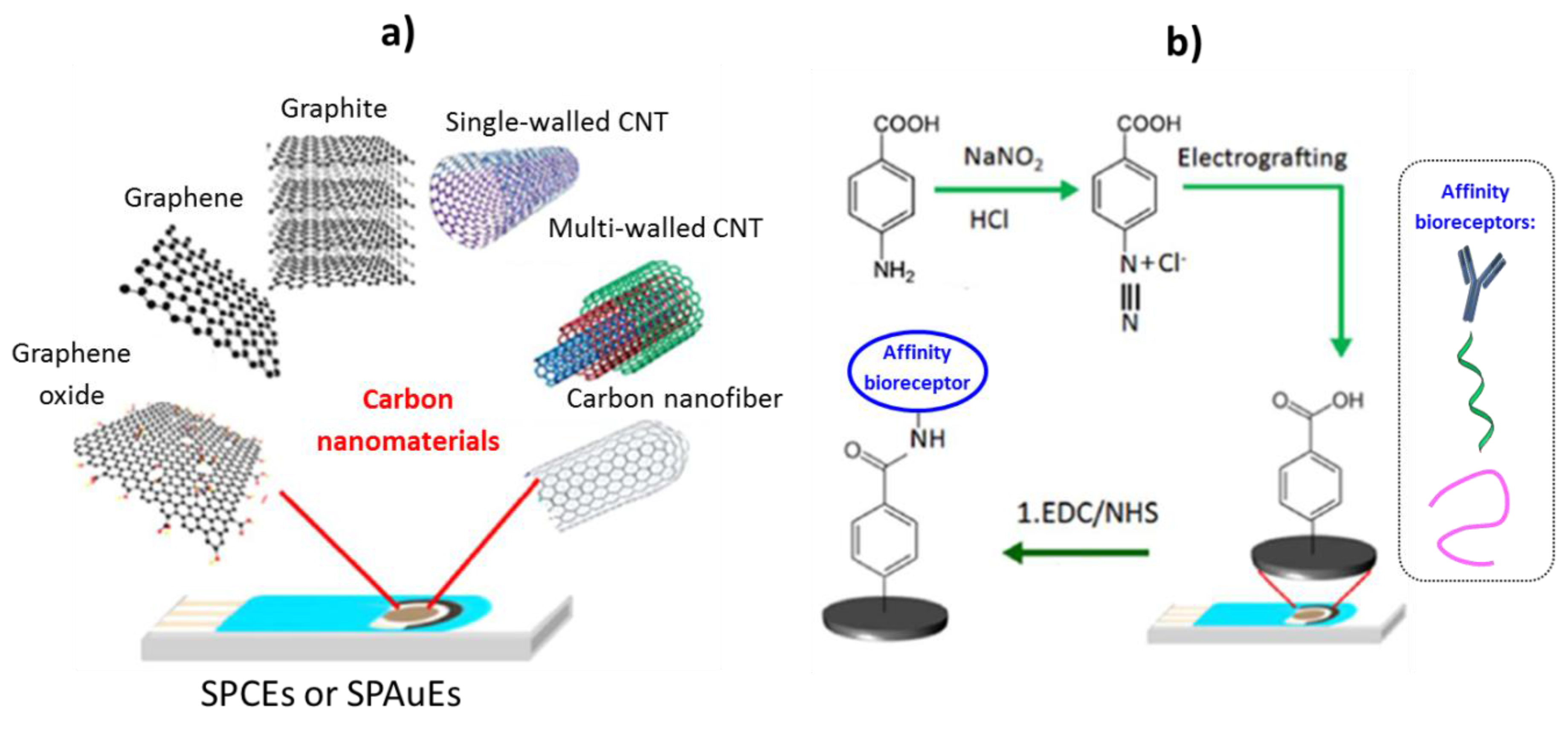
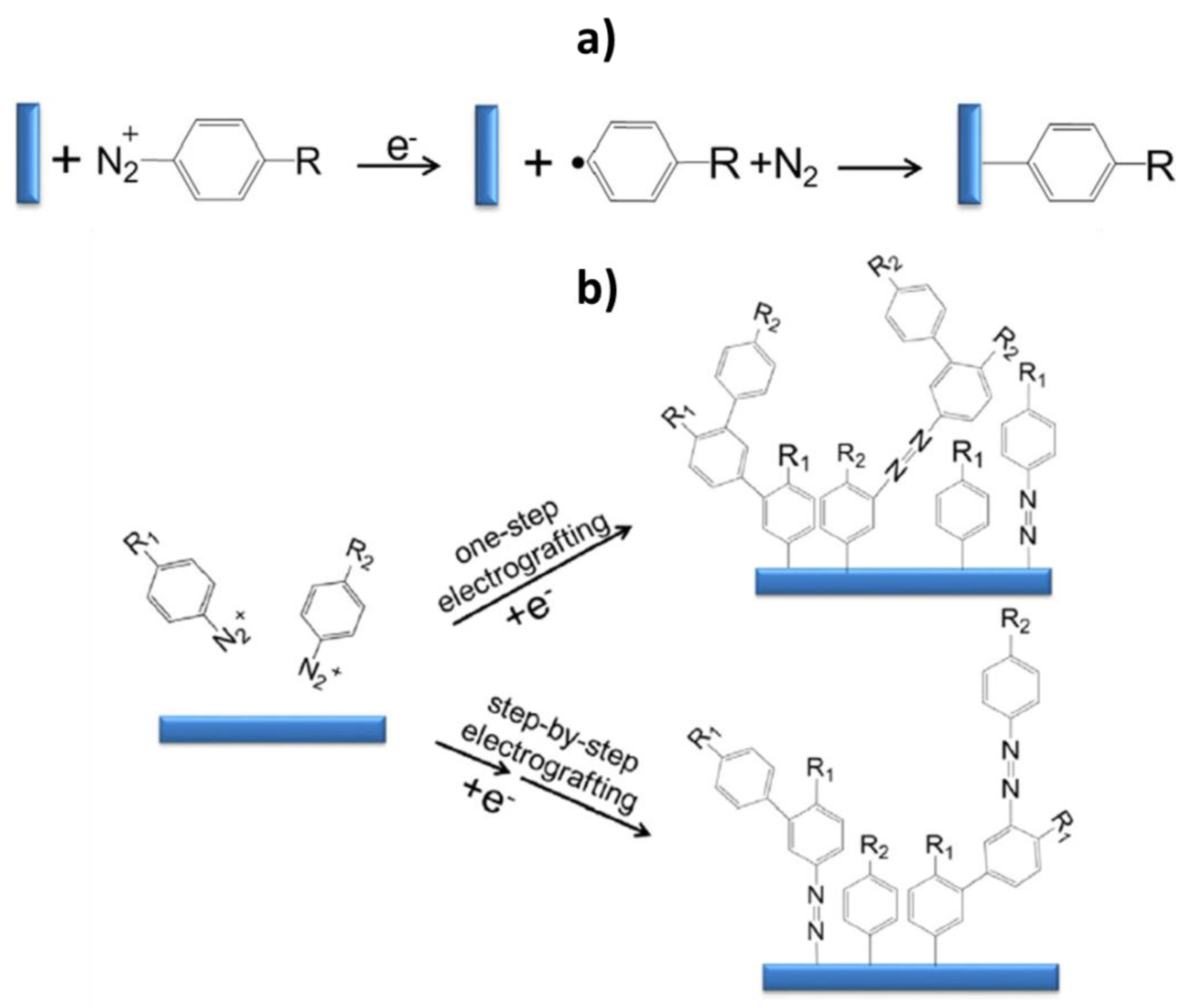



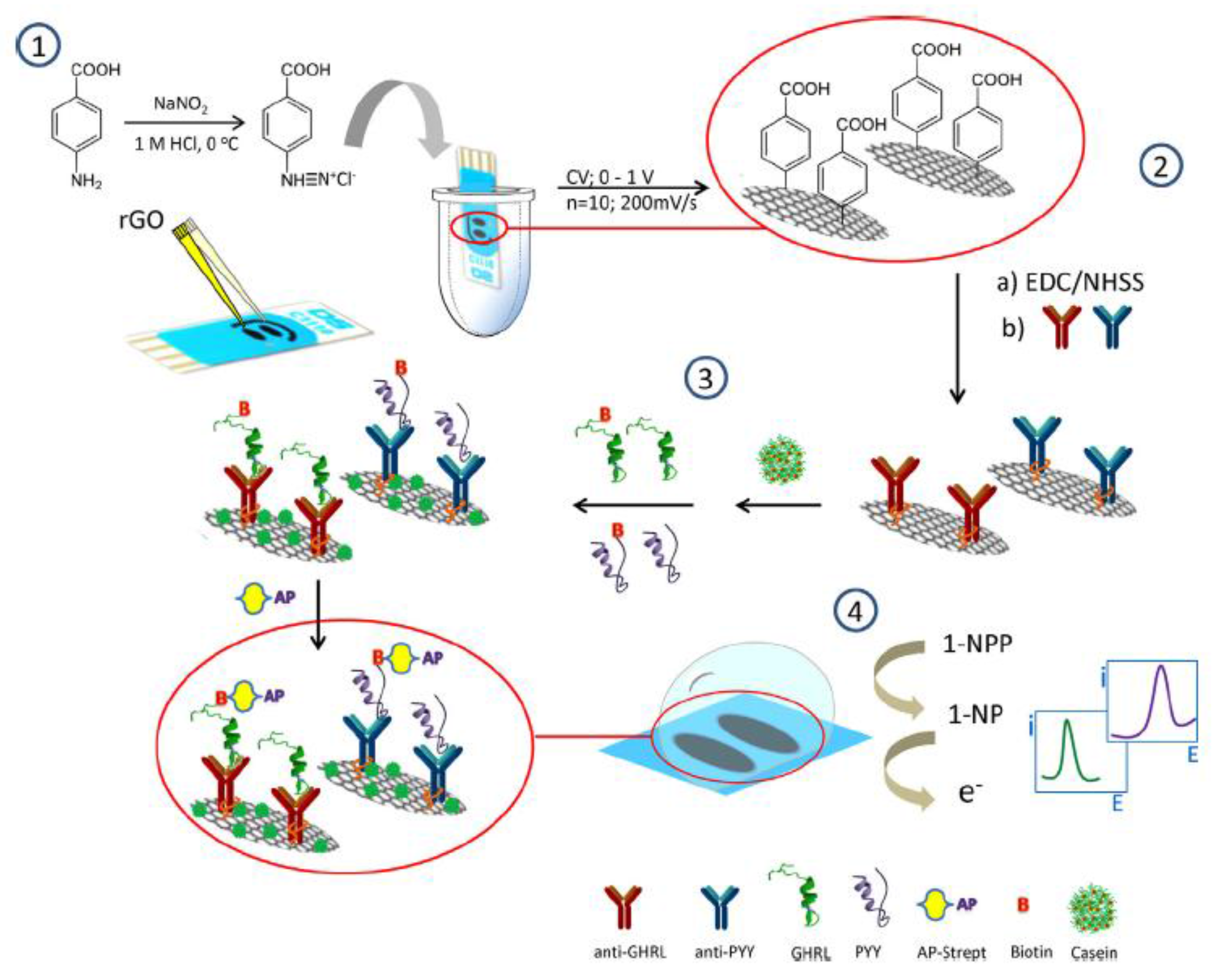
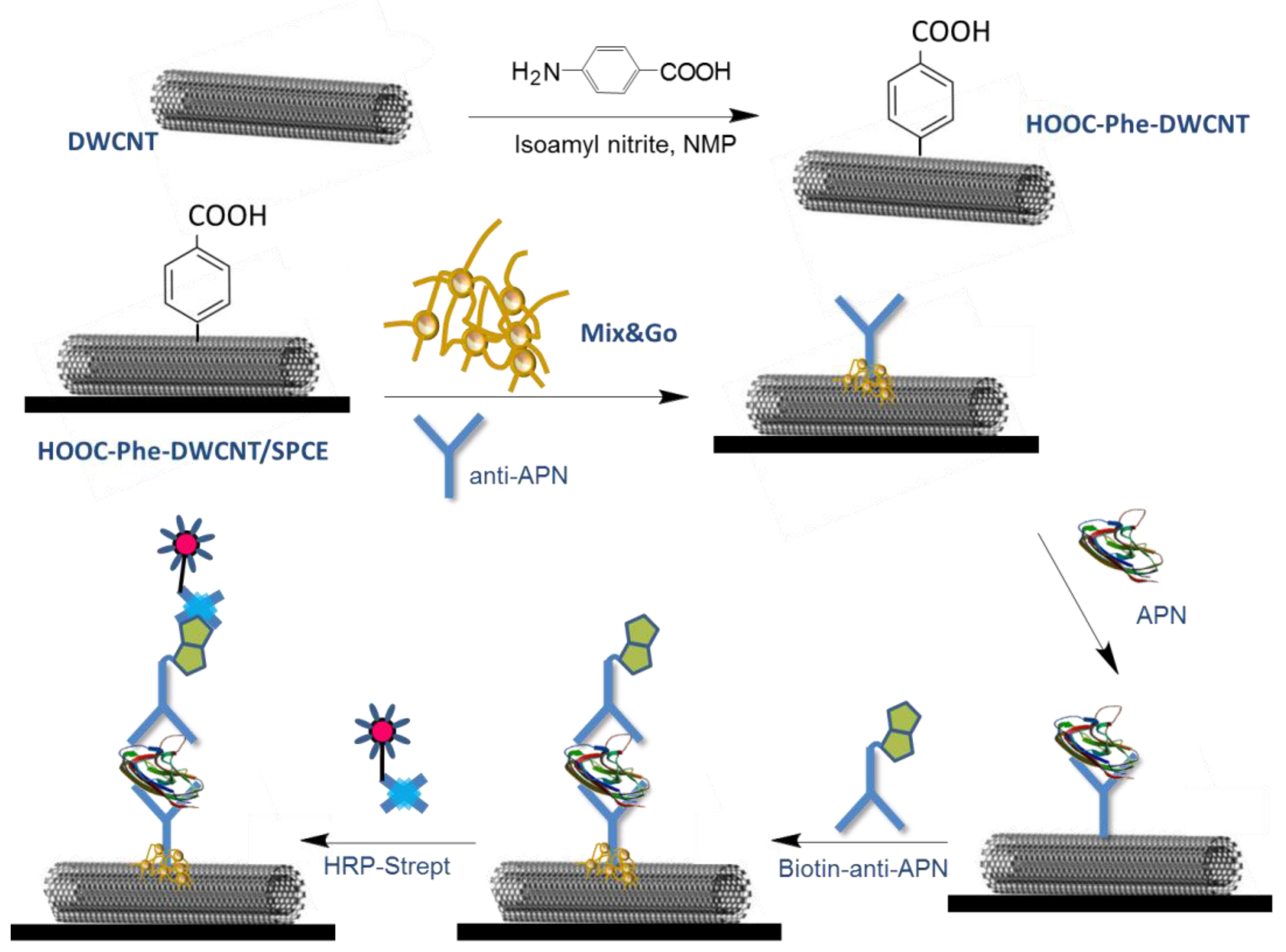

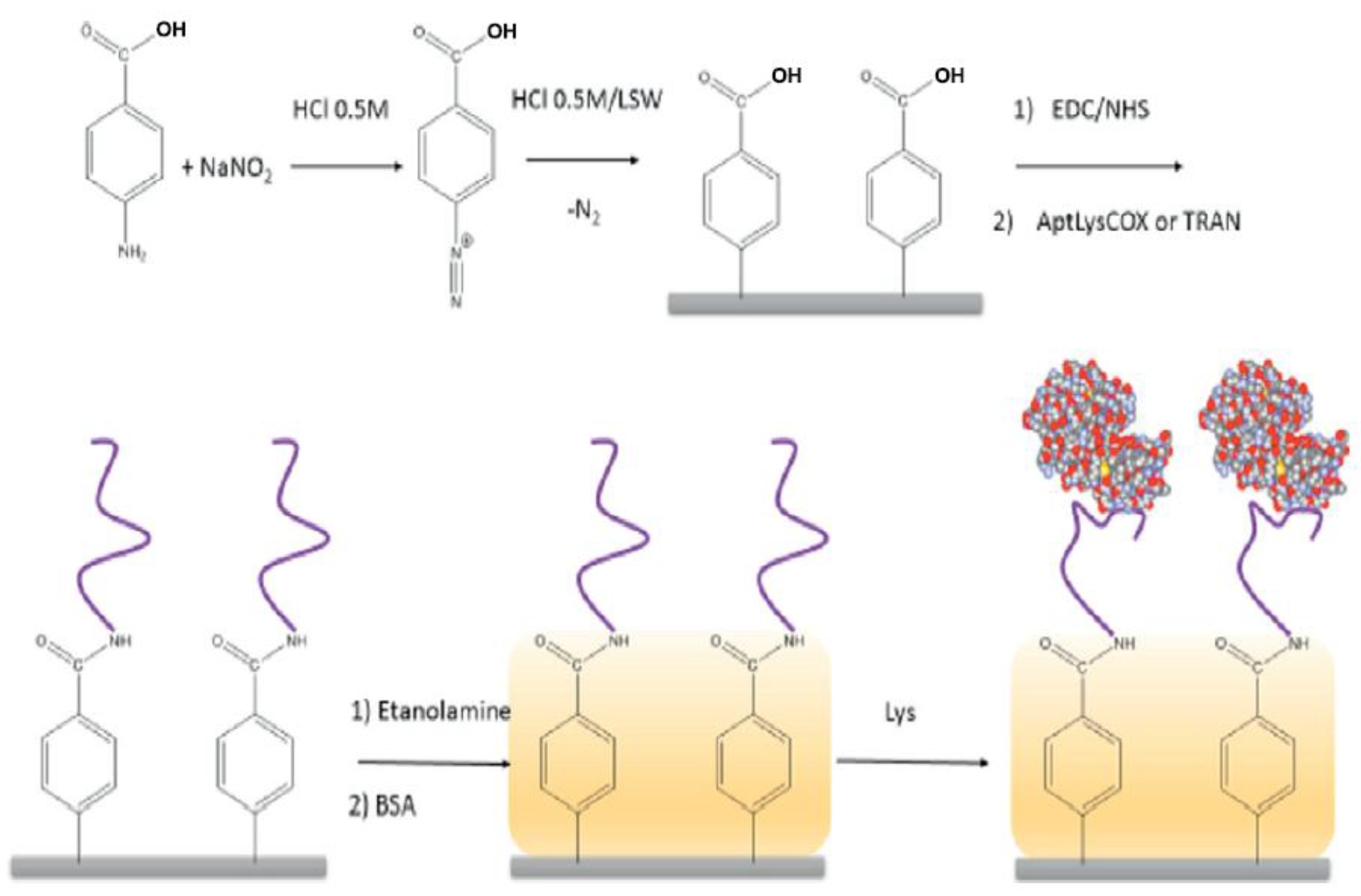
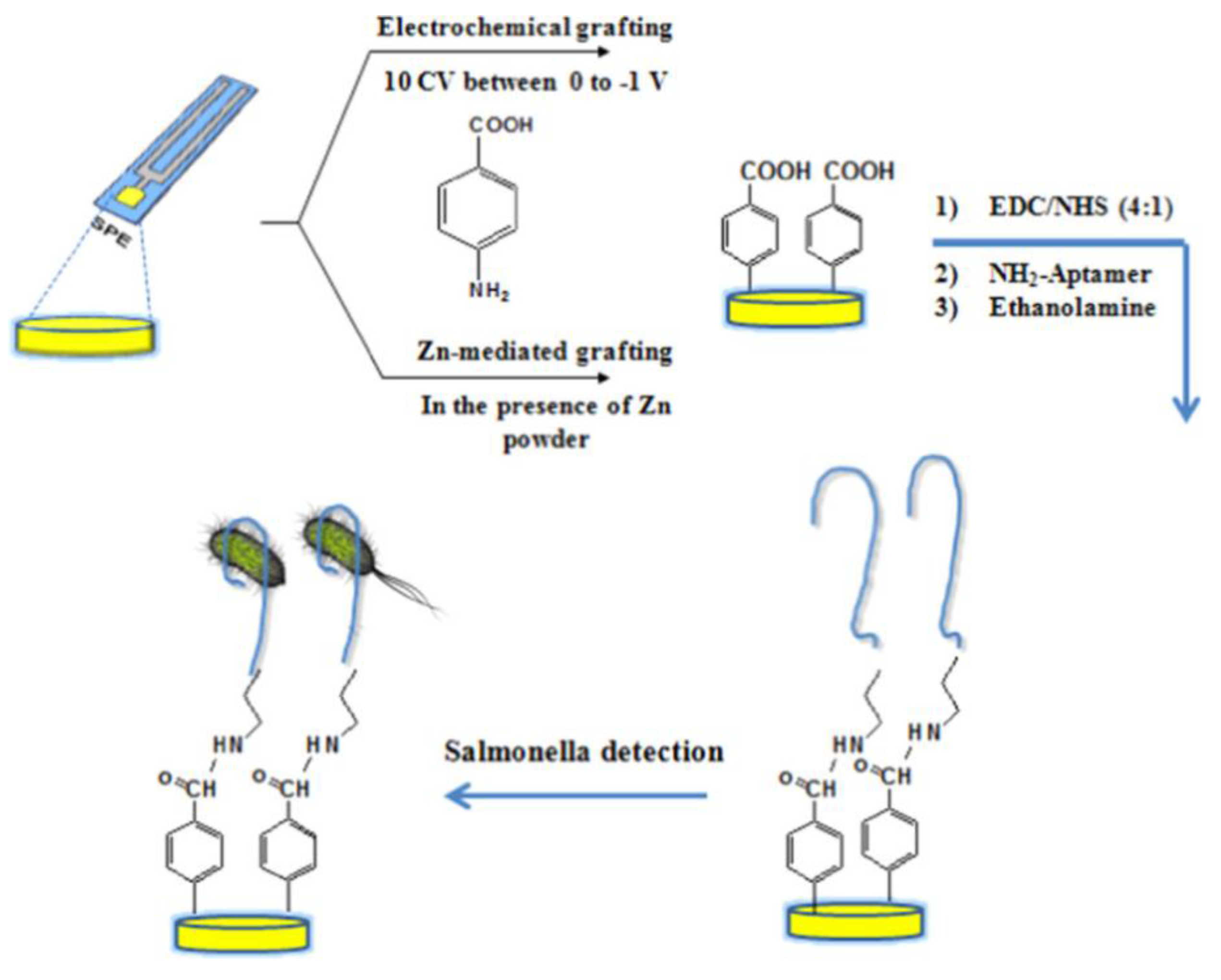
| Electrode | Configuration | Analyte | Detection Scheme | Detection Technique | Linear Range | LOD | Sample | Ref. |
|---|---|---|---|---|---|---|---|---|
| SPCE | Sandwich immunosensor, grafted p-ABA-4-APBA-anti-ACTH-ACTH-Biotin-Strept-AP | ACTH | 1-NPP + AP → 1-NP 1-NP → quinone | DPV | 0.025–1.0 pg mL−1 | 18 pg L−1 | serum | [19] |
| SPdCE | Sandwich immunosensor, grafted
p-ABA-4-APBA-anti-ACTH-ACTH-Biotin-Strept-AP Direct competitive, grafted p-ABA-4-APBA-anti-cortisol-cortisol-AP | ACTH cortisol | 1-NPP + AP → 1-NP 1-NP → quinone | DPV | 5.0 × 10−5–0.1ng mL−1 0.1–500 ng mL−1 | 40 pg L−1 37 pg mL−1 | serum | [85] |
| SPCE | Sandwich immunosensor, grafted p-aminothio-phenol-AuNPs-anti-BNP-BNP-anti-BNP-HRP | BNP | H2O2 + HRP + HQ → quinone | amperometry | 0.014–15 ng mL−1 | 4 pg L−1 | serum | [84] |
| SPCE | Sandwich immunosensor, grafted p-ABA-DWCNTs-M&G-anti-APN-APN-Biotin-Strept-HRP | APN | H2O2 + HRP + HQ → quinone | amperometry | 0.05–10.0 μg mL−1 | 14.5 ng mL−1 | serum | [86] |
| SPdCE | Direct competitive immunosensor, grafted p-ABA-anti-GHRL GHRL-Biotin-Strept-HRPDirect competitive, grafted p-ABA-anti-PYY- PYY-Biotin-Strept-HRP | GHRLPYY | H2O2 + HRP + HQ → quinone | DPV | 10−3–100 ng mL−1 10−4–10 ng mL−1 | 1.0 pg mL−1 0.02 pg mL−1 | serum, saliva | [62] |
| SPdCE | Sandwich immunosensor, grafted p-ABA-DWCNTs -M&G-anti-TNF-TNF-anti-TNF-Biotin-poly-Strept-HRP. Sandwich, grafted p-ABA-DWCNTs-M&G-anti-IL1β-IL1β-anti-IL1β-Biotin-poly-Strept-HRP | TNF-α IL-1β | H2O2 + HRP + HQ → quinone | amperometry | 1–200 pg mL−1 0.5–100 pg mL−1 | 0.85 pg mL−1 0.38 pg mL−1 | serum saliva | [87] |
| SPCE | Sandwich immunosensor, grafted p-ABA-Strept-Biotin-anti-TGF-TGF-anti-TGF-SWCNT(-HRP)-Phe-V | TGF-β1 | H2O2 + HRP + HQ → quinone | amperometry | 2.5–1000 pg mL−1 | 0.95 pg mL−1 | saliva | [88] |
| SPAuE | Direct competitive immunosensor, grafted 4-nitrophenyl red.-GA-anti-OTA-HRP | OTA | TMB reduction | amperometry | up to 60 ng mL−1 | 12 ng mL−1 | - | [89] |
| SPCE | Indirect competitive immunosensor, grafted 4-carboxy-phenyl-HMDA-OA-anti-OA-IgG-AP | OA | 1-NPP + AP → 1-NP 1-NP → quinone | DPV | - | 1.44 ng L−1 | mussel | [5] |
| SPCE array | Sandwich immunosensor, grafted 4-aminophenyl-GA-anti-CEA(or anti-AFP)-anti-CEA(or anti-AFP)-HRP | CEAAFP | H2O2 + HRP + HQ → quinone | amperometry | 0.10–50 ng mL−1 | 0.03 ng mL−1 0.05 ng mL−1 | serum | [90] |
| SPCE | Label free immunosensor, grafted 4-carboxyphenyl-anti-OA-OA | OA | RCT [Fe(CN)6]4−/3− | EIS | 0.195–12.5 μg mL−1 | 0.3 μg L−1 | mussel | [58] |
| GrSPE | Label free direct competitive immunosensor, grafted 4-carboxyphenyl-anti-OA-OA-OVA | OA | reduction current [Fe(CN)6]4−/3− | SWV | up to 5000 ng mL−1 | 19 ng L−1 | shellfish tissue | [59] |
| GrSPE | Label free immunosensor, grafted 4-nitrophenyl red.-GA-anti-β-LGB-β-LGB | β-LGB | reduction current [Fe(CN)6]4−/3− | DPV | 1 pg mL−1–100 ng mL−1 | 0.85 pg mL−1 | cake, cheese, snacks | [20] |
| CnFSPE | Label free immunosensor, grafted 4-carboxyphenyl-anti-pSA-pSA | pSA | reduction current [Fe(CN)6]4−/3− | DPV | 0.5–500 pg mL−1 | 0.5 pg mL−1 | fresh meat | [61] |
| CnFSPE | Label free immunosensor, grafted 4-carboxyphenyl-anti-pSA-pSA | SMN | reduction current [Fe(CN)6]4−/3− | SWV | 1.0 pg mL−1–100 ng mL−1 | 0.75 pg mL−1 | whole blood | [33] |
| GrSPE | Label-free immunosensor, grafted 4-carboxyphenyl-anti-OVA-OVA | OVA | reduction current [Fe(CN)6]4−/3− | DPV | 1.0 pg mL−1–0.5 μg mL−1 | 0.83 pg mL−1 | egg-free cake | [60] |
| SPCE | Label free aptasensor, grafted 4-carboxyphenyl-aptamer AFB1 | AFB1 | RCT [Fe(CN)6]4−/3− | EIS | 0.125 ng mL−1–16 ng mL−1 | 0.12 ng mL−1 | beer wine | [91] |
| SPCE | Label free immunosensor, grafted 4-carboxyphenyl-acetic-anti-MUC4 | MUC4 | RCT [Fe(CN)6]4−/3− | EIS | 1–15 μg mL−1 | 0.33 μg mL−1 | serum | [64] |
| SPCE | Label free aptasensor, grafted p-ABA -aptamer-OTA | OTA | RCT [Fe(CN)6]4−/3− | EIS | 0.15–2.5 ng mL−1 | 0.15 ng mL−1 | cocoa beans | [92] |
| SPCE | Label free aptasensor, grafted 4-carboxyphenyl-aptamer-AFM1 | AFM1 | RCT [Fe(CN)6]4−/3− | EIS | 2–150 ng L−1 | 1.15 ng L−1 | milk | [93] |
| SPCE | Label free DNA sensor, grafted 4-nitrophenyl red.-DNA | MRP3 gene | reduction current Ru(NH3)63+ | DPV | 1.0–7.3 ng μL−1 | 210 pg μL−1 | - | [94] |
| SPCE | Label free aptasensor, grafted 4-carboxyphenyl-NH2-aptamer-salmonella | S. typhi. | RCT [Fe(CN)6]4−/3− | EIS | 10–108 CFU mL−1 | 6 CFU mL−1 | apple juice | [95] |
| SPCE | Sandwich aptasensor, grafted 4-carboxyphenyl-aptamer-anti-Lys-Biotin-avidin-AP | Lys | 1-NPP + AP → 1-NP 1-NP → quinone | DPV | 5 fM–5 nM | 4.3 fM | wine | [70] |
| SPCE | Label free aptasensor, grafted 4-((trimethylsilyl)ethynyl) benzene- p-nitrobenzene + click azide aptamer-OTA | OTA | RCT [Fe(CN)6]4−/3− | EIS | 1.25–500 ng L−1 | 0.25 ng L−1 | beer | [21] |
© 2018 by the authors. Licensee MDPI, Basel, Switzerland. This article is an open access article distributed under the terms and conditions of the Creative Commons Attribution (CC BY) license (http://creativecommons.org/licenses/by/4.0/).
Share and Cite
Yáñez-Sedeño, P.; Campuzano, S.; Pingarrón, J.M. Integrated Affinity Biosensing Platforms on Screen-Printed Electrodes Electrografted with Diazonium Salts. Sensors 2018, 18, 675. https://doi.org/10.3390/s18020675
Yáñez-Sedeño P, Campuzano S, Pingarrón JM. Integrated Affinity Biosensing Platforms on Screen-Printed Electrodes Electrografted with Diazonium Salts. Sensors. 2018; 18(2):675. https://doi.org/10.3390/s18020675
Chicago/Turabian StyleYáñez-Sedeño, Paloma, Susana Campuzano, and José M. Pingarrón. 2018. "Integrated Affinity Biosensing Platforms on Screen-Printed Electrodes Electrografted with Diazonium Salts" Sensors 18, no. 2: 675. https://doi.org/10.3390/s18020675






